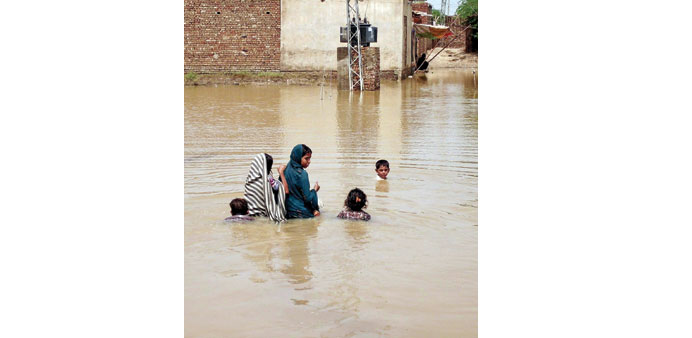By Steff Gaulter
|
|
At the beginning of this week, the weather was rather strange in Doha. There was a fair amount of low cloud, not really the weather you’d expect in the month of August. At one point it even looked as if there might be a shower.
Elsewhere in the region, the weather has been even more peculiar. Rain fell in parts of Oman and the UAE. Thunder rolled across Dubai and Abu Dhabi, and the rain poured so hard in Ibri, in northern Oman, that several of the wadis overflowed.
For the most part, the weather in Oman and the UAE was simply an interesting talking point, but further east the weather was far more severe. Heavy rain pounded parts of Pakistan and Afghanistan, causing major problems and loss of life.
In Pakistan, rains initially hit the mountainous north of the country — 82mm (3.22 inches) of rain was reported in Bannu, in the Khyber Pakhtunkhwa province. This triggered landslides and swept away people’s homes. The rain even managed to cross the mountains and fall in eastern parts of Afghanistan as well.
Normally, the high mountains in northern Pakistan shield Afghanistan from the monsoon rains, and almost no rain falls between June and October. The average rainfall in Kabul in August is just 1.6mm (0.06 inches). As you might expect, rainfall statistics are difficult to obtain from Afghanistan, but estimates from satellite imagery put the amount of rain from this storm at less than 50mm (2 inches). That doesn’t sound like a lot of rain, but when you consider that the region is very mountainous and the houses are mostly built with mud, the severity of the situation is more evident.
The rain poured down the mountain side, forming vast torrents of water. Over 200 houses were swept away by the storms, and at least 80 people are now known to have died, with many more still missing.
After devastating parts of northern Pakistan, the rains then focused on the south of the country. 41mm (1.6 inches) of rain was recorded in Karachi, slighty less than the monthly average of 60mm (2.4 inches), but the rainfall was very patchy. At the air force base just to the west of Karachi, 79mm (3.1 inches) was reported.
Although there had been plenty of thunderstorms in the preceding few weeks, the amount of rain has been little more than a trace. This ensured the ground around Karachi was baked hard by the sun. As the rain poured down, it formed large puddles, which quickly developed into vast floods.
At least 19 people were killed by the flood waters in the city, many of whom were electrocuted in the flood waters, or died when their houses collapsed in on them. In Jacobabad, about 400km (250 miles) to the northeast of Karachi, the rain was even heavier; in just 48 hours, 196 mm (7.72 inches) of rain fell across the city. This is more than five and a half times the average that is expected in the entire month. No rain had been reported in the city since 2 July, so the ground could not readily absorb the water.
Jacobabad is a city that has been badly hit by flooding over the past few years. The 2010 monsoon rains were the worst on record in Pakistan, and submerged approximately one-fifth of country’s total land area. Jacobabad was not spared; it was inundated when the mighty river Indus River burst its banks.
One of the very few positive outcomes of the 2010 floods was that the silt which was deposited by the Indus River vastly improved the fertility of the land. This turned out to be a short-lived benefit, however, as the silt was all but washed away by the flooding two years later.
The flooding in 2012 didn’t simply race through the region, instead the city remained submerged for weeks. At its most extensive, 95% of the district of Jacobabad was underwater. The flooding in Jacobabad this year, the third time in four years, saw rivers and irrigation canals quickly becoming overwhelmed.
Riverbanks were breached and dykes failed. Homes and businesses were flooded as over 40,000 acres of crops were washed away. After pouring water across southern parts of Pakistan, the thunderstorms then drifted west, across southern Iran.
Lightning lit up the skies as the rain edged toward the Arabian Peninsula, but as the system edged across Iran and the Gulf, it slowly petered out.
An area of high pressure dominates our region at this time of year, and this stamps on any weather system that tries to move towards us. These latest thunderstorms fared no differently and they lost energy as they crept towards us. There was still a good deal of moisture in the air when it reached us; we felt the stifling humidity in Qatar and we also saw the clouds, but the energy had been taken away from the atmosphere.
By the time it reached the Arabian Peninsula the rain was generally light and patchy, and the majority of the rain that fell was over the mountains. The area of high pressure above us was certainly a blessing; I don’t want to imagine how much damage Qatar would have suffered if nearly 200mm (7.87 inches) of rain had fallen in two days, like it did in Jacobabad. However, I have to admit to being slightly disappointed that we didn’t see a shower at all.
I like thunderstorms and they’re few and far between in Doha’s summer. The last time there was a thunderstorm here in August, was in 2005, and unfortunately we will have to wait a little longer before we see the next one.
(The author is Senior Weather Presenter at Al Jazeera English channel. She can be contacted on [email protected]
or on Twitter at @WeatherSteff)



